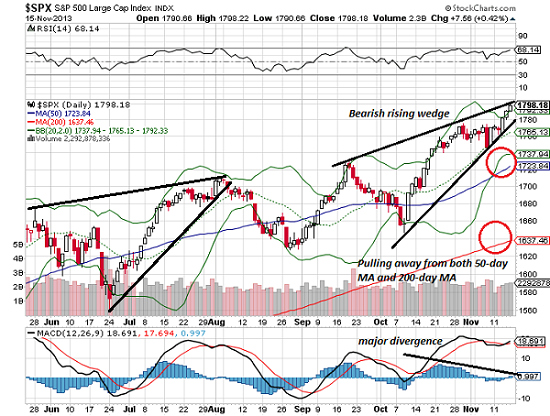Submitted by Charles Hugh-Smith of OfTwoMinds blog,
It may appear to be safe for everyone to be on the same side of the boat, but the gunwale is awfully close to the water.
Gee, we're all on one side of the boat now–long the S&P 500, NASDAQ, Dow, Eurozone stocks, the Nikkei, not to mention rental housing, junk bonds, bat quano, 'roo belly futures and the quatloo–basically every "risk-on" trade on the planet–is that a problem?
The conventional (and convenient) answer is "nah–stocks can only rise from here." So what if market bears have fallen to 15% or less? So what if 85% of investors are on the same side of the boat? You'd be nuts to leave the winning side, the trend-is-your-friend side, the "don't fight the Fed" side, the side with all the "smart money."
It may appear to be safe for everyone to be on the same side of the boat, but the gunwale is awfully close to the water. With the sea remarkably calm (i.e. no waves of turbulence or volatility), the fact that the boat is overloaded doesn't seem dangerous.
But once the sea rises even a bit and water starts lapping over the gunwale, the "guaranteed safety" of the bullish trade might start looking questionable.
When the boat takes on water quicker than anyone believes possible and capsizes, it will be "every punter for himself." But few longside punters are wearing lifejackets.
This is all Investing 101: be wary of extremes of euphoria and confidence and being on the same side of the trade as everyone else. Yet everyone continues adding to their long positions without adding portfolio protection (puts, etc.):

Three indicators suggest this move will reverse shortly, either in a "healthy correction" or a reversal of trend–which one cannot be determined until the downturn is underway.
The rapid rise of the market has traced out a bearish rising wedge. This pattern usually leads to some sort of correction. The MACD histogram is divergent, dropping to the neutral line as the SPX has soared ever higher.
Lastly, price has pulled away from both the 50-day and 200-day Moving Averages, suggesting the rubber band is remarkably stretched.
Round-number attractors are close at hand. The SPX at 1798 is two measly points from the round-number attractor of 1800, and the Dow at 15,961 is a coin-toss away from its round-number attractor of 16,000. This level will invite great cheering ("new all time high," never mind adjusting for inflation) and also present an opportunity for the imbalanced boat to capsize.
Even more astonishing, the crowd is also betting on volatility declining from extreme lows. Look at the put and call options on the VXX, a security that tracks the short-term volatility of the VIX: at the money December calls (bets volatility will rise by December 20) number 311 while puts (bets volatility will decline some time between now and December 20) number 11,265.
Hey, you 311 bears! Join us 11,265 longs on the guaranteed winning side of the boat! Uh, thank you for the kind offer, but no thanks. Though the uncrowded side is uncomfortably above the water at this point, with 11,265 fattened Bulls on the side close to the waterline, the few on this side are less likely to be trampled when physics trumps psychology.
Hey all you PhDs in Behavioral Economics: perhaps you could investigate the "how many angels can dance on the head of a pin?" nature of this psychological conundrum:the market can only do what few expect of it, so if everyone is looking for bubbles, there can't be any bubbles. But what else do you call a market that rises 10+% in a mere 6 weeks?
In other words, if people are looking at the market and realizing it is dangerously close to capsizing, then it can't capsize because the market can only capsize if nobody expects it. The absurdity of this argument is revealed by turning it around: if Bulls confidently expect the market to keep rising, then how can it rise when everybody expects it to rise?
The answer to the question "how many angels can dance on the head of a pin?" is the same as the answer to the question, "How many Bulls can crowd on one side of the trade without capsizing the boat if there are 311 Bears on the other side?" The absurdly concise answer is 11,265–at least for now.
![]()
via Zero Hedge http://feedproxy.google.com/~r/zerohedge/feed/~3/i8oTZoO4pzM/story01.htm Tyler Durden




